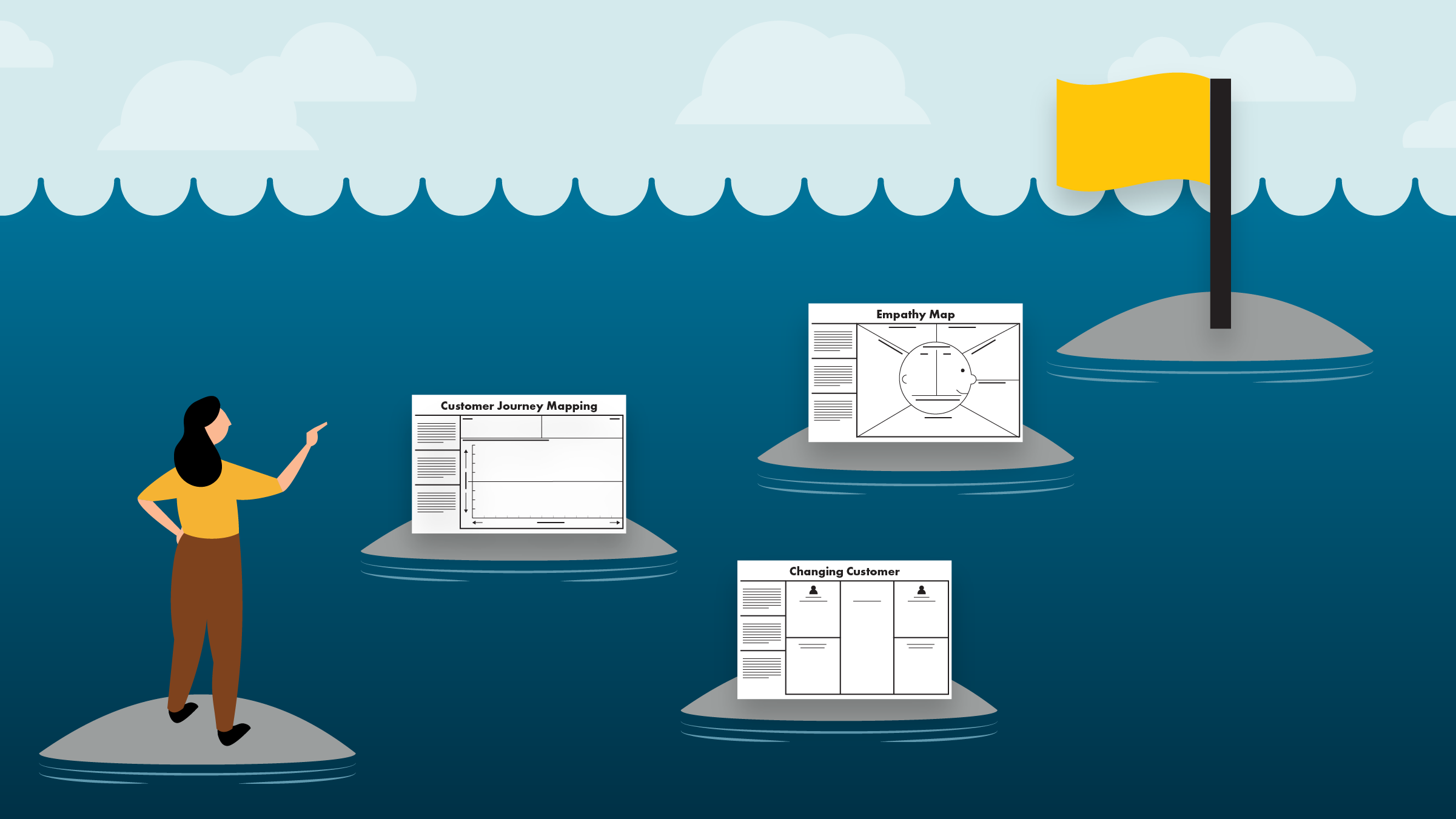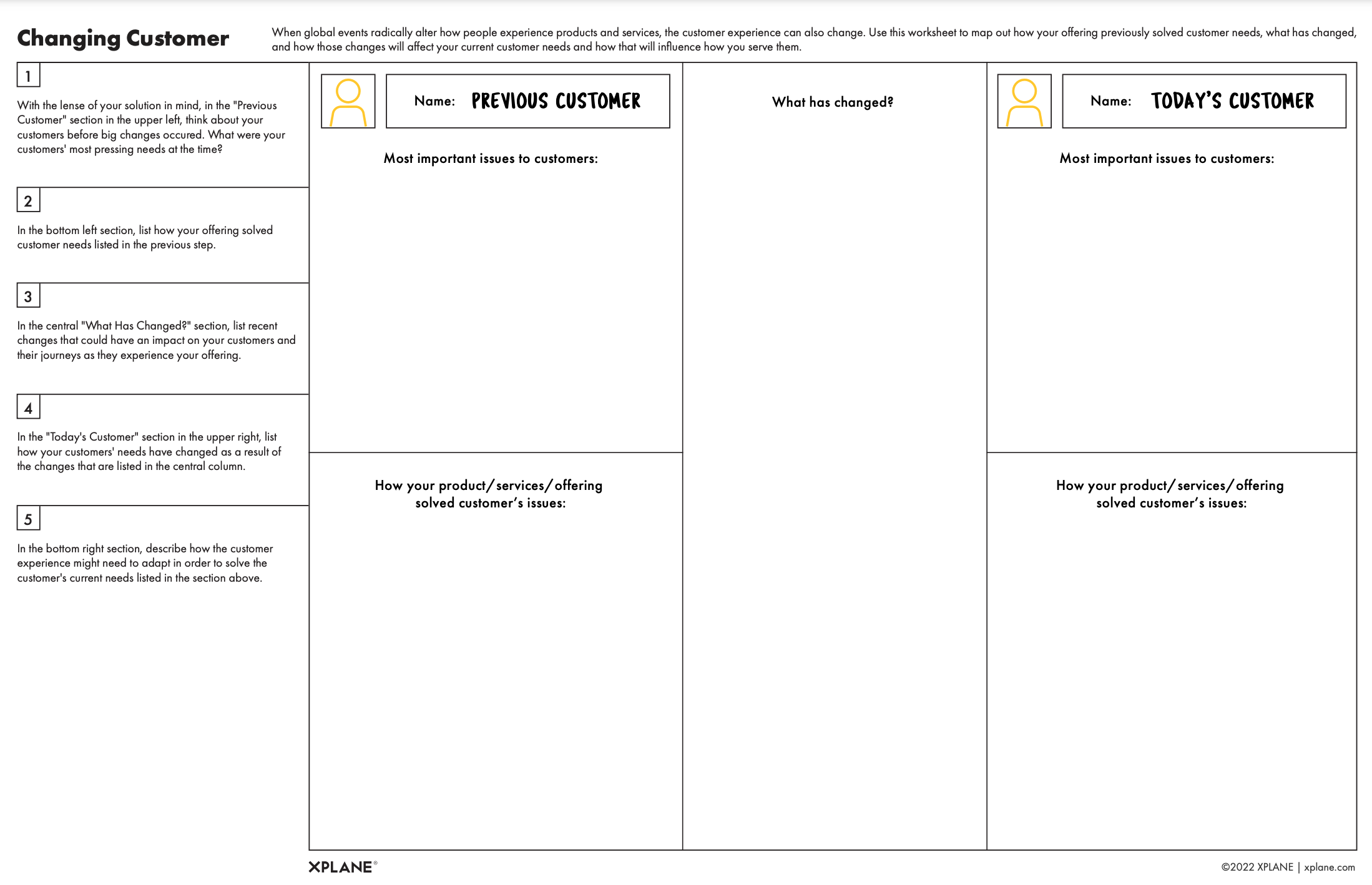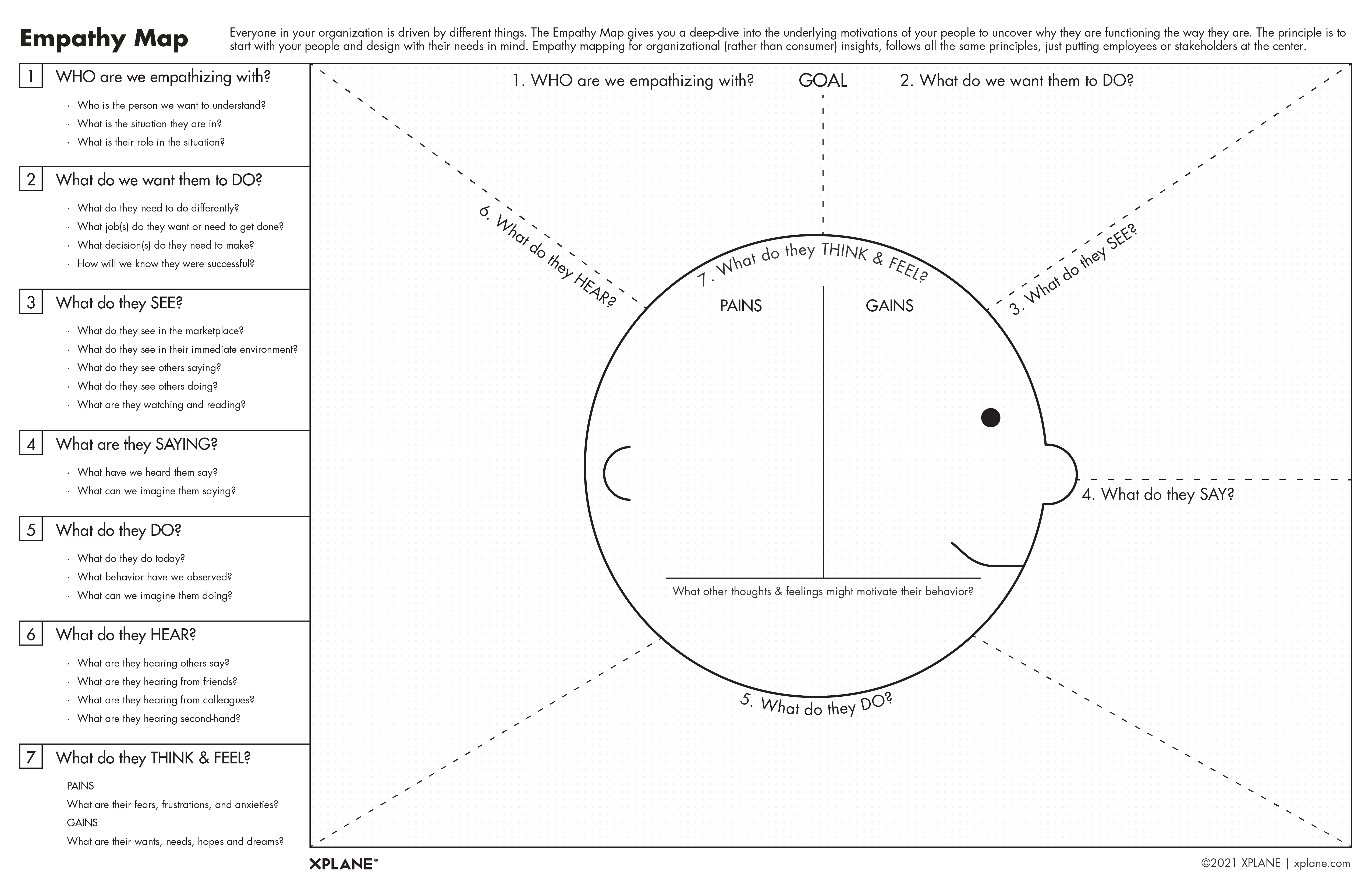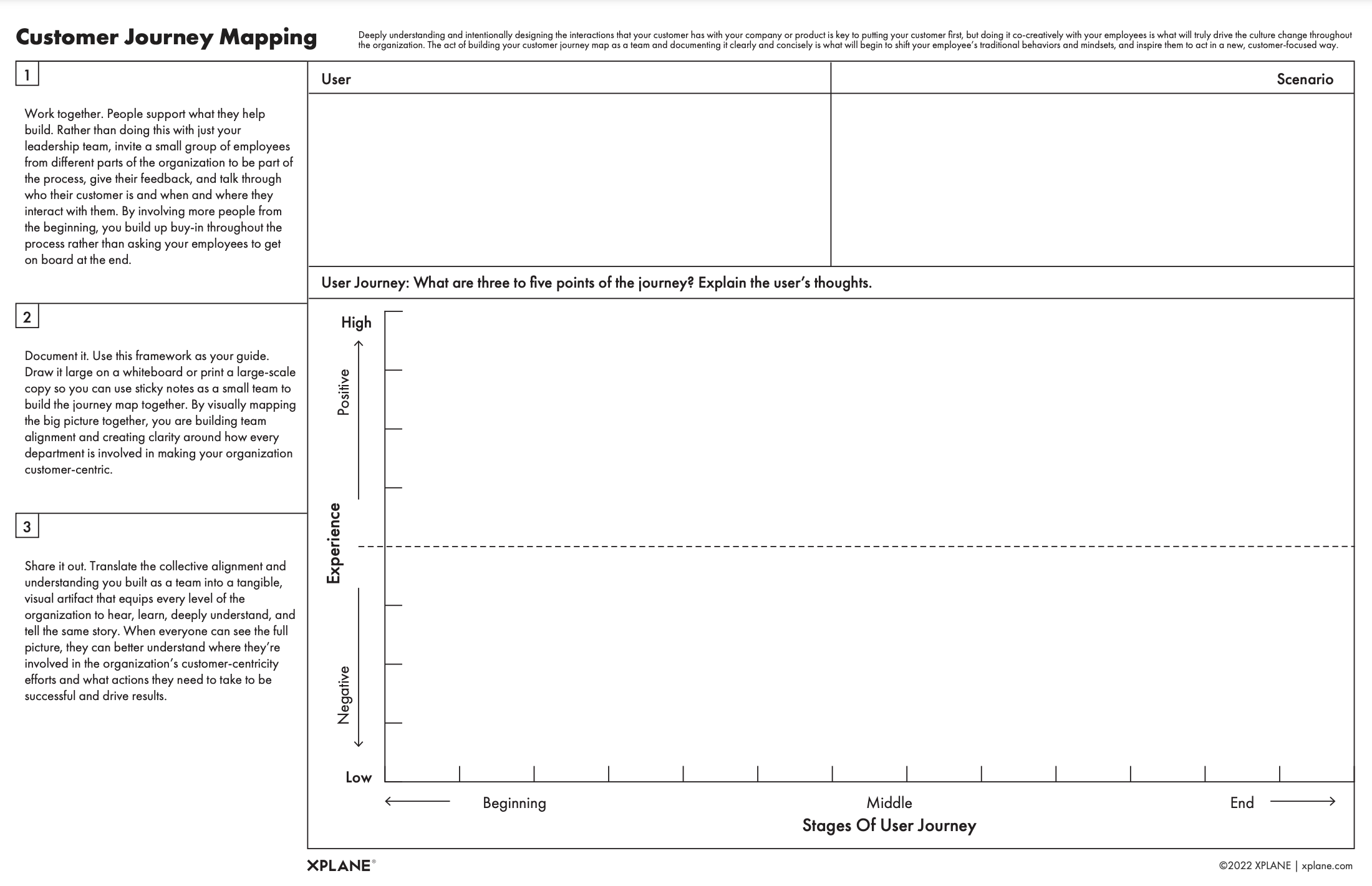Feeling a little out of step with your customers at this stage of the pandemic? Hit your stride again with these three worksheets that will help you better understand and respond to your customers’ needs today.
Recently, I heard the phrase “I’d like to go back to living in ‘precedented’ times.”
Calamitous changes over the past three years have affected nearly every facet of modern life, particularly how people buy and use things. Consider your own purchasing habits in 2019, as opposed to now. Customers have changed in significant ways, with a re-orientation around hybrid work; a new mindset around how, what, and why they consume; and a shift in what makes a product valuable.
As we all know, without customers, there is no business. So how does an organization improve customer-centricity and better align its offerings with customers’ changing expectations and values?
XPLANE has authored numerous worksheets, games, and other tools to help organizations diagnose, prepare for, plan, refine, improve, and execute strategy. The three worksheets discussed here can help you understand what has changed for customers, dig deep into their decision-making process, and plot the customer journey with an eye toward what can be improved.
How Have Customers Changed? (Changing Customer Worksheet)
Many organizations have been trying to keep their heads above water and have not yet asked themselves how their customers have changed.
Our first worksheet—Changing Customer Worksheet—provides a strong “then vs. now” picture of the customer landscape. The impact of this worksheet increases when strong subject matter experts (like front-line sales and marketing experts) and of course, real customers, are questioned.
To begin, consider how your customers experienced your offering(s) prior to March 2020. What was most important to your customers back then? Once you’ve listed a few ideas, move down the worksheet to record how your offering solved top-of-mind issues for your customers at that time. List several ideas for both primary customer issues and how your organization’s offering solved those problems.
Next, consider what has changed for your customer. Use notes and drawings to put a picture together of how the world has changed. Focus on things that are different, and without trying to solve any problems yet, broadly consider changes in the ecosystem that customers are now navigating. First-person research and customer insights can buoy this section as well.
Now move to the right side of the worksheet. How might what you’ve learned and what has changed broadly affect, increase, or negate issues that were important to customers before vs. now? For example, a retail organization that sold its product in stores might realize that their customers are now making the bulk of their purchases online.
Finally, on the bottom right, based on your clearer understanding of the customer’s current situation and needs, identify ways in which your offering can solve their issues. Using the example above, customers reducing their brick and mortar retail shopping habits might prompt a shift in the way the organization approaches its sales strategy, investing in improved SEO and online sales capabilities to better meet today’s customers where they are.
What Are Customers Thinking and Feeling? (Empathy Map)
Now that you have a clearer picture of your current customer and how they view the world, you can delve deeper into how they think and what motivates their behavior.
The Empathy Map is a tool that can help organizations better understand the inner motivations behind a customer’s decision-making. Again, the closer you are to your customer, the better the insights.
- Best practice: For more comprehensive insights, leaders should complete several separate empathy maps of the same customer persona, then compare them to identify consistent themes.
To use the empathy map, first define WHO your subject is and what you want them to DO as a result of your work. At a high level, the WHO is your customer and the DO is the action they take with your offering.
Building an understanding of what’s going on around the customer will help you understand how they make decisions. List the external elements (what your customers see, say, do, hear) to form a better understanding of the internal elements (or what a customer thinks and feels). Plot these thoughts and feelings under the customer’s current pains and gains or fears and opportunities.
Visualizing the Customer Journey (Customer Journey Map)
The third worksheet, the Customer Journey Map, adds the dimension of time. It helps clarify the journey the customer embarks upon when interacting with your offering.
As with the first two worksheets, multiple explorations—asking different people to contribute to or complete the worksheet—are critical in pulling together key themes and insights from this worksheet. The framing is fairly simple. At the top of the Journey Map, determine who is the user (or customer) you’re focusing on and the scenario you’re exploring. This establishes the goalposts of your playing field.
Next, determine the primary steps of the customer journey. Consider specifically where the customer has touchpoints with the product or offering throughout the lifecycle of the interaction.
Note: While the worksheet recommends you list three to five touchpoints here, don’t be constrained by the physical space on the page. A digital whiteboard or large whiteboard with the same framework can offer you space to add a few more critical touchpoints.
As key points of interaction are established, you now can understand how those touchpoints resonate with the customer. Understanding where along the customer journey the offering is strong and where it might be weaker gives you valuable insight into where your organization should focus for an improved customer experience.
The example below shows how this information can be used with some simple visualization to help people take action.
In the example, an organization took the “temperature” of the customer journey at different points along the way. They felt the early stages of the customer journey were particularly weak, whereas the middle implementation and support phases were considerably stronger. They also identified weaknesses at the tail-end of the journey.
Using this information, the organization identified several opportunities (or actions) they could take to address areas of weakness in the journey.
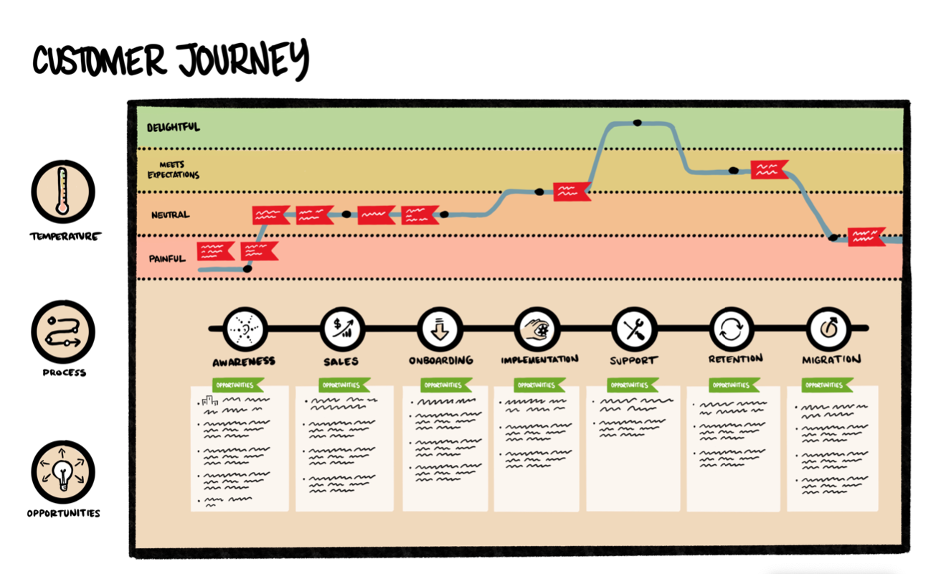
Get Back in Step with Your Customers!
The bigger culture change needed for a sustained shift in customer focus requires engaged leaders and a multi-pronged campaign of tools, messaging, and activities that touch almost every facet of an organization. Obviously, no organization can go from customer-aloof to customer-centric in a day, but the tools shared here can help a team get off to a good start.
Let us know how it goes if you use any of these worksheets and if you have other favorite customer-centric tools!
Additional Resources
And to learn more about how to help your company become more customer-centric, we recommend the following resources:
